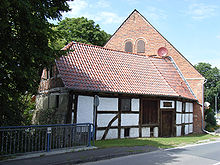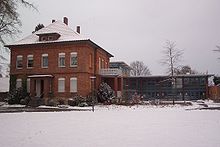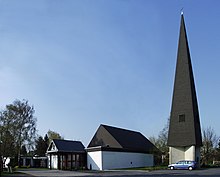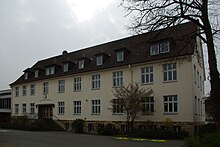Elsen (Paderborn)
|
Elsen
City of Paderborn
Coordinates: 51 ° 44 ′ 0 ″ N , 8 ° 41 ′ 0 ″ E
|
|
|---|---|
| Height : | 112 m above sea level NN |
| Area : | 20.19 km² |
| Residents : | 16,116 (Jul 31, 2013) |
| Population density : | 798 inhabitants / km² |
| Incorporation : | 1st January 1975 |
| Postal code : | 33106 |
| Area code : | 05254 |
|
Location of the Elsen district in Paderborn
|
|
Elsen is a western district of Paderborn in the east of North Rhine-Westphalia . The place has around 16,000 inhabitants. Until 1974 Elsen was an independent municipality in the office of Schloss Neuhaus .
geography
Elsen is located in the east of the Westphalian Bay in the transition area from the Hellwegbörde to the lip lowlands about 4.5 kilometers from Paderborn city center - in the triangle between Bielefeld , Dortmund and Kassel .
Starting in the north in a clockwise direction, the Paderborn districts of Sande , Schloss Neuhaus , the core town and the district of Wewer as well as the Salzkotten district of Scharmede and the Delbrück district of Bentfeld border on Elsen .
The municipality has an area of 20.19 square kilometers. The north-south extension is about six kilometers and the east-west extension about five kilometers.
Elsen is divided into the center (Elsen village), surrounded by Elsen train station in the south, Gesseln in the west and Nesthausen in the north. Each of the four districts celebrates its own shooting festival .
The town center is grouped around a small hill, on the top of which stands the Catholic St. Dionysius Church. This knoll forms the center of the village, where there are also many shops. Outside the village there is the small nature reserve Elser Holz / Rottberg in the southwest . The landscape is generally characterized by wide, open fields and meadows.
The largest flowing water is the Alme on the eastern edge of the village. The largest lake in the village is Nesthauser See in the north , where gravel is extracted. The Gunne , a small stream that often dries up in summer, flows through Elsen .
history
On the basis of Germanic and Roman finds from the Elsen area, which date back to the third millennium BC, one can conclude that the Germanic peoples took possession of the Elsen area long before the birth of Christ.
Aliso - a Roman camp in Elsen?
Aliso is an old Roman camp on the Lippe , about the exact location of which science is still divided today. The camp is important because Publius Quinctilius Varus started the journey from there, on which he was attacked by Teutons under Arminius and defeated in the Varus Battle . Prince-Bishop Ferdinand von Fürstenberg made the claim in his main work "Monumenta Paderbornensia" that the old Roman camp was located in the vicinity of Elsen. He substantiates these claims with the similarity of the names and the proximity to the Lippe on which the camp is said to have been. Some well-known researchers such as Theodor Mommsen later followed this thesis. Archaeological excavations in Elsen have not brought any finds to light, according to the findings of the linguists, a tracing of the old place name "Ilasan" back to "Aliso / Elison" is quite unlikely and finally the Roman camp Anreppen was discovered in 1968 only seven kilometers from Elsen - all evidence that speaks against Elsen as Aliso Castle.
middle Ages
There is little evidence of the early centuries of the old parish and village of Elsen. The Ilasan court , which was subordinate to the main court Nigenhus (Neuhaus), was first mentioned in 1036. With a deed of donation, the Paderborn Bishop Meinwerk transferred the court to the newly founded Canon Foundation (later renamed Busdorfstift ), to which the Tithing was payable. In a copy of this document from the 15th century, the spelling of the place name is already Elesen .
The Alt-Enginger mill, one of the oldest preserved buildings in the Paderborn region , is mentioned for the first time in a document from 1058, with which Bishop Imad assigned the fish pond and the mill located next to it to the Abdinghof monastery .
The farm Ilasan was in the Middle Ages seat of standing in the service of the Paderborn bishop low noble family , the knights "Elsen" , which was first mentioned in the 1177th The establishment of new farms and the division of farms led to settlement expansion and densification in the vicinity of the Meier farms administered by knights and ministers , especially in the area of the church on the Gunne and in Gesseln, which is documented in 1209 in the form of “Gestelen”. The scattered settlement character was retained.
Elsen's appearance took off in the course of the 13th – 15th centuries. Century, solid social classes emerged and a brand cooperative was founded. According to excavation results, the Ilasan farm, which was later given the name Steinhof , was the center of a fortification with a wall and moat around the church hill with the Dionysius church, which was converted into a fortified church, and was therefore of great importance for the development of a village center.
16th century to 1850
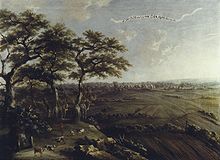
In the 16th to 18th In the 18th century, Elsen was part of the absolutist principality of Paderborn . During a big fire in the village during the fasting week of 1506, 14 houses burned down, probably a large part of the buildings at that time. In the Thirty Years 'War (1618–1648) and in the Seven Years' War (1756–1763), the village suffered from troop stationing and occupations of Paderborn and the surrounding area, and the effects of the war from 1794 onwards were also very stressful.
In 1802 the prince-bishopric of Paderborn lost its state independence with the occupation by Prussia , but fell back to the Kingdom of Westphalia for a few years in 1807 and to Prussia in 1813 after the Napoleonic defeat. Elsen was incorporated into the province of Westphalia , founded in 1815, and by decree of the royal government in Minden came to the Paderborn district, founded in 1816 . When the districts were divided into offices , Elsen came to the Neuhaus office .
Elsen's transition from a prince-bishop's village to a Prussian rural community brought with it diverse and far-reaching changes, such as the division of brands , which were not, however, abrupt. The previously jointly owned large heather and forest areas Elser Heide and Elser Holz - now under individual use - were converted into arable land or cut down within a few decades , so that today only street and field names are reminiscent of this. The Elser Holz / Rottberg nature reserve is located in the area of the former Elser Holz .
1850 to 1975
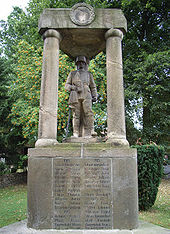
The construction of the Paderborn– Lippstadt railway line in the years 1850–1853 heralded the beginning of the industrial age . A structural change took place in the village, which until now had been purely agricultural, due to the settlement of small industrial and craft businesses . The new establishments provided employment opportunities for workers outside of agriculture. These and the workers employed in the surrounding area settled in the new district of Elsen-Bahnhof. Elsen also grew faster and faster - if the village still had 903 inhabitants in 1818, the number of inhabitants had grown to 3538 in 1939. On March 1, 1913, the PESAG tram line 6 from Paderborn train station to Elsen was put into operation, the end of which was on the Dicken Linde in Gesseln.
The time of National Socialism has also left its mark on Elsen since 1933. The National Socialist ideology was reflected in the village celebrations: in 1934 the local gymnastics club celebrated its 40th anniversary - a festival that was welcomed by the National Socialists who were keen on physical fitness. In July 1939, the 50th anniversary of the war comradeship turned into a three-day festival, with 40 foreign associations taking part in the pageant. After the beginning of the Second World War, forced laborers mainly from the East were used on the local farms . The farmers, who profited not insignificantly from the use of the forced laborers, treated the foreign workers differently - some treated them badly, others gave them food. During the war there was a camp for around 60 foreign forced laborers, mainly from the West (Belgians, French), in the hall of the “Römerkrug” restaurant. They were used to repair the Paderborn Central Station . In 1941 17–21 Poles were housed in the brick building of the Junk company in Elsen.
Elsen was spared the major bombing raids on Paderborn in the spring of 1945, which destroyed over 85 percent of the city. Due to the influx of bomb victims from the Paderborn city center, however, there was a strong increase in the population. The place was handed over to the Americans without a fight on April 2, 1945, but had to bear the burden of billeting occupation troops and over 1,300 evacuees in the following period.
With the official dissolution of Prussia and thus also the province of Westphalia by the Allied Control Council in 1947 and the previous establishment of the state of North Rhine-Westphalia in 1946, the administrative district of Minden and thus also the municipality of Elsen became part of the new state of North Rhine-Westphalia. When the Federal Republic of Germany was founded in 1949, Elsen also became part of the Federal Republic.
After the war, many evacuees and displaced persons settled there. The following years were characterized by new residential construction, NATO built a settlement for over 1000 employees, Von-Ketteler-Strasse slowly acquired “city character” and Elsen finally developed into a residential suburb. In the 1950s, the entire PESAG tram network was dismantled in favor of an omnibus network; the last trip on the Paderborn – Elsen route took place on March 31, 1958.
1975 until today
As part of the North Rhine-Westphalian territorial reform , the previously independent municipality, which belonged to the Neuhaus Castle Office, was approved on January 1, 1975 with the "Law for the reorganization of the municipalities and districts of the Sauerland / Paderborn area ( Sauerland / Paderborn law )" from 5. November 1974 merged with the city of Paderborn and the communities of Benhausen, Dahl, Neuenbeken (mostly), Sande and Schloss Neuhaus to form the new city of Paderborn. At that time only about 10% of the population lived from agriculture and the place continued to grow steadily. In 1986 the place celebrated its 950th anniversary (since it was first mentioned in a document in 1036) with a large parade.
Population development
| year | Residents |
|---|---|
| 1803 | approx. 900 |
| 1849 | 1,124 |
| 1939 | 3,538 |
| 1960 | 4,817 |
| 1961 | 4,895 |
| 1970 | 6.314 |
| 1974 | 7,802 |
| 2006 | 15,695 |
| 2013 | 16,116 |
| 2016 | 16,374 |
Religions
The majority of Elsen's population is Catholic and belongs to the parish of St. Dionysius Elsen in the Paderborn deanery of the Archdiocese of Paderborn .
The Evangelical Lutheran residents belong to the Evangelical Lutheran. Parish of Elsen in the Paderborn parish of the Evangelical Church of Westphalia .
Catholic parish
The Catholic parish church of St. Dionysius and St. Urban is located on a small hill and dominates the Elsen townscape. The massive, five-story, Romanesque tower from the 11th / 12th centuries. Century towers over all other buildings in the place today as then. For a long time the church was also the mother church of the Neuhaus and Sande communities .
In earlier centuries, in the middle of the stone courtyard with the ring-shaped fortification, the church had the function of a fortified church , as indicated by a 42 centimeter wide and 170 centimeter high inner wall staircase in the tower.
There is no evidence of the founding of the Elsen Church. However, there are indications that it already existed in 1036, the year the town was first mentioned in a document, and that it was probably founded in the Carolingian era . The fact that St. Dionysius, the first bishop of Paris , is one of the saints who enjoyed special veneration in the Carolingian Franconian Empire and who brought his relics to Paderborn in the course of the Christianization of the Sachsenland through one of the relic translations customary at the time . It should be one of the oldest churches in the diocese of Paderborn .
Due to the rapid growth of the community in the 19th century, the old parish church quickly became too small, so that it was finally replaced by a larger one in 1851. Only the tower of the old church has been preserved. The continued great growth of the community made another extension necessary in 1925. The precious neo-Gothic windows date from the beginning of the 20th century and shape the neo-Gothic church interior to this day.
In St. Dionysius there is an above-average number of priestly vocations.
Evangelical Lutheran parish
After a Protestant congregation was formed in Paderborn in 1802, the church records only show the first Protestant residents in Elsen in 1896. Their number grew slowly to a total of seven families by 1939. After the Second World War , there was a large influx of Protestant Christians from the Ruhr area and from Silesia , Pomerania and East Prussia throughout the Paderborn region . From 1947 the Protestant residents of Elsen, who now numbered several hundred, belonged to the newly established pastorate for the Paderborn rural districts. Their number grew rapidly in the following decades, so that in 1965 their own church, the Church of the Redeemer , was built. In 1982 Elsen became a separate parish of Paderborn and in 1987 it became an independent parish to which Scharmede also belongs.
politics
District Committee
According to § 3 Paragraph 2 of the main statute of the city of Paderborn, the Paderborn City Council forms a district committee for the Paderborn-Elsen district. This is made up as follows:
- CDU : 6 seats
- SPD : 3 seats
- Alliance 90 / The Greens : 2 seats
- DIP : 1 seat
- FDP : 1 seat
- Advisory members: FBI 1 seat, ALFA, now LKR 1 seat
- Chairman: Alois Lienen (CDU)
coat of arms
The coat of arms shows a red rafter on a white background, underneath a striding (i.e. one paw raised), red lion. On the helmet a wide open red hat, behind it a green treetop, which possibly originally represented a peacock frond. It was the family coat of arms of the Elsen knight dynasty that was first mentioned in 1177. The Knights of Elsen named themselves after the old farm Ilasan , which also gave the entire village of Dorf its name. The shape of the shield is typical of the 16th century and gives an indication that the von Elsen family died out with Margarete von Elsen in 1656 through marriage to the von Diepenbrock family; the coat of arms has therefore not been changed since then.
At the beginning of the 1970s, however, a simplified representation of the coat of arms without a helmet and a treetop and with a standing lion was used by the savings and loan fund Elsen as the company logo. This logo found widespread use and is now regarded by many Elseners as the Elsen coat of arms. It is now even used by several Elsen clubs (Schützen, TuRa, Spielmannszug).
Buildings
Economy and Infrastructure
Elsen has two business parks , Fohling and Am Mühlenteich . The Paderborn's city center attributable Industrial Park Alme east of Alme is a part also in the area of the old district Elsen. Most of the companies in the IT sector are based in this industrial park.
Elsen is the seat of Volksbank Elsen-Wewer-Borchen with further branches in Wewer, Alfen, Etteln, Kirch- and Nordborchen. Furthermore, there is a branch of the Volksbank Paderborn-Höxter-Detmold and the Sparkasse Paderborn in Elsen .
traffic
The federal motorway 33 Bielefeld - Wünnenberg -Haaren runs on the eastern edge of the village . On the northern edge of the village, the federal highway 64 runs from the direction of Münster with the motorway junction Paderborn-Schloß Neuhaus. At the southern Elsens with the motorway junction Paderborn-center from the direction Soest extending coming B 1 , which at the connection point Paderborn-Elsen north-east-bound up behind snakes as pure motor road direction Hameln and Hannover leads.
The nearest train station is the one in the Salzkotten district of Scharmede on the Hamm – Warburg railway line, just less than a kilometer behind the city limits . the closest long-distance train station is Paderborn Hauptbahnhof . The former stop on the Hamm – Warburg railway in the Elsen-Bahnhof district has been closed.
The Paderborn / Lippstadt Airport is located less than 20 kilometers away and can be reached via a good road.
The PaderSprinter (formerly PESAG ) carries city traffic with buses and connects Elsen with all other Paderborn districts. In regional bus traffic, Elsen is approached by some lines of BahnBus Hochstift GmbH .
Public facilities
In the center of Elsen there is an administrative branch of the Paderborn city administration, to which an office of the Neuhaus Castle Police Station is attached.
On the southwestern outskirts of the Salzkotten district of Scharmede is the central waste disposal site Alte Schanze of the Paderborn district, founded in 1979 .
education
Elsen has two primary schools , the Comenius School and the Dionysius School , as well as one comprehensive school , the Paderborn-Elsen comprehensive school . In addition, the site has seven kindergartens, four of them in urban, two in Catholic and a Protestant in sponsorship .
Sports
The largest sports club in Elsen is TuRa Elsen 1894/1911 e. V. 14 departments now belong to the TuRa Elsen. In alphabetical order these are: badminton, basketball, disabled sports, soccer, handball, carnival, athletics, chess, swimming, dancing, tennis, table tennis, gymnastics and volleyball. The TuRa has grown to be just over 3,000 strong in the course of time. In 2005 Bernd Kürpick took over the chairmanship from Alfons Bernard, Rudi Mersch and Alfons Bernard are honorary chairmen.
The shooting sports club St. Hubertus Elsen has been shooting in the air rifle Bundesliga since the 2004/2005 season and was German team champion in 2006, 2012, 2016 and 2017.
Personalities
The author Josef Hißmann (1907–1989) was born in Elsen. According to him, which is Josef Hißmann street named.
Honorary citizen
The former municipality of Elsen granted the following people honorary citizenship:
- 1910: Joseph Schnitz (1847–1912), Paderborn Vicar General (since 1901) and Provost . Josef-Schnitz-Straße in Elsen is named after him.
- 1932: Pastor Franz Bals (1861–1935), Catholic parish pastor from 1917 to 1935. Franz-Bals-Strasse in Elsen is named after him.
- 1952: Prelate Bernhard Sinn (December 9, 1878– August 19, 1961), pastor to St. Maria-Magdalena in Omaha , Nebraska , clergyman to the Archdiocese of Paderborn
- 1959: Theodor Plesser (1880–?), Honored citizen of the community
- 1963: Pastor Heinrich Mentrop, Catholic parish pastor
literature
- Heimat- und Verkehrsverein Elsen e. V. (Ed.): Elsen. Old community - young part of town . General editor Josef Drewes. Bonifatius-Druckerei, Paderborn 1986.
- Wilhelm Hucke: The parish of Elsen then and now . Junfermann printing works, Paderborn 1960.
- Josef Segin, Rolf-Dietrich Müller: Chronicle of the community of Elsen 1901–1974 . Bonifatius-Druckerei, Paderborn 2008.
Web links
- City-Portal Paderborn: Elsen
- Unofficial homepage of the Elsen district
- Portal with current information, dates and event photos from Elsen
- Heimat- und Verkehrsverein Elsen eV
- Elsen (Paderborn) in the Westphalia Culture Atlas
Remarks
- ↑ So reports Göbel Schickenberges , chronicler of the Böddeken monastery , who sent support for the injured ( Die Chronik Bruder Göbel. Notes of a lay brother from the monastery Böddeken (1502–1543) , published by Heinrich Rüthing , Verlag für Regionalgeschichte, Bielefeld 2005, p. 83). See also Günter Wißbrock on the fire, 500 years ago: Devastating large fires in Elsen, Paderborn and Neuhaus in the spring of 1506 , in: Elsener Nachrichten , ed. from Heimat- und Verkehrsverein Elsen, No. 169, spring 2006, pp. 9–17, here pp. 9/11.
- ↑ See Käthe Sander-Wietfeld, Elsen. Old community - young part of town , in: Elsen. Old community - young part of town , p. 49–80, here p. 70.
- ↑ See, for example, the report by the forced laborers Lycyna Kabacinska and Anna Krysinska (in conversation with Heinz Paus on October 23, 2003 in Warsaw), reproduced by Christa Mertens, Zwangsarbeit in Paderborn, 1939–1945 , Paderborn 2005, p. 87.
- ↑ Cf. Mertens, Zwangsarbeit in Paderborn , pp. 20–21 and the document Stadtarchiv Paderborn / G 2732 printed on p. 16.
- ↑ Mertens, Zwangsarbeit in Paderborn , p. 25, State Archives Detmold M1 IP No. 1696 (printed by Mertens, p. 10).
- ^ Federal Statistical Office (ed.): Historical municipality directory for the Federal Republic of Germany. Name, border and key number changes in municipalities, counties and administrative districts from May 27, 1970 to December 31, 1982 . W. Kohlhammer, Stuttgart / Mainz 1983, ISBN 3-17-003263-1 , p. 328 .
- ↑ Max von Spießen (ed.), Book of Arms of the Westphalian Nobility , Verlag CA Starke, Görlitz 1901–1903, plate 111.


